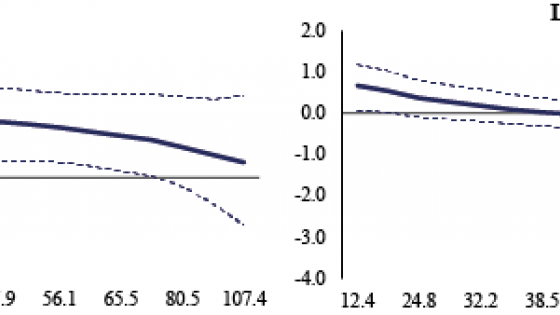During the Great Recession of 2008-09, a number of countries around the world deployed fiscal stimulus to support activity. As a result, government debt and deficits increased in many countries, and they remain elevated (Huidrom et al. 2016a). Against this backdrop of weak fiscal positions, there has been a revival of interest in fiscal policy as a macroeconomic stabilisation tool (Blanchard and Leigh 2013, Mohlmann and Suyker 2015).
Yet, there is scant evidence regarding the extent to which fiscal policy is effective in stimulating the economy – i.e. the size of fiscal multipliers – over different phases of the business cycle, when implemented against the backdrop of weak initial fiscal positions. In this column, we analyse the relationship between fiscal multipliers and fiscal positions of governments by addressing three questions. First, we ask whether fiscal multipliers depend on the strength of the fiscal position. Second, we analyse whether this state-dependency on the fiscal position is distinct from cyclical effects. Finally, we examine the channels through which the fiscal position affects multipliers.
Dependence of fiscal multipliers on fiscal position
Fiscal multipliers tend to be larger when the fiscal position is stronger. Fiscal multipliers that depend on the fiscal position are estimated in an interacted panel vector autoregressive (IPVAR) model, and using a large dataset of advanced and developing economies in our paper (Huidrom et al. 2016b). The key econometric innovation is that model coefficients, and hence fiscal multipliers, evolve deterministically according to the fiscal position, which is taken to be the government debt-to-GDP ratio. The results indicate that multipliers are systematically larger when the fiscal position is strong (i.e. government debt is low), and vice versa when it is weak. For instance, the long-run multiplier is close to unity when debt is low, but is negative for high levels of debt (Figure 1).
A weak fiscal position can therefore blunt the stimulative effects of expansionary fiscal policy. This is not simply because a weak fiscal position constrains governments from spending more. In fact, the results suggest that fiscal expansion is more quickly unwound when the fiscal position is strong than when weak.
Figure 1 Fiscal position-dependent multipliers
Note: The graphs show the conditional fiscal multipliers for different levels of fiscal position at select horizons. These are based on estimates from the IPVAR model, where model coefficients are conditioned only on fiscal position. Government debt as a percentage of GDP is the measure of fiscal position and the values shown on the x-axis correspond to the 5th to 95th percentiles from the sample. Fiscal position is strong (weak) when government debt is low (high). Solid lines represent the median, and dotted bands are the 16-84% confidence bands.
The independence from cyclical effects of state-dependency on fiscal position
The effect of the fiscal position on fiscal multipliers is distinct from that of the business cycle. Recent studies have established that multipliers depend on the phase of the business cycle – they tend to be larger during recessions than expansions (e.g. Auerbach and Gorodnichenko 2012). The fiscal position is endogenous and varies according to the business cycle. To isolate the impact of the fiscal position alone on multipliers, it is important to control for business cycle effects in the estimation. For this, fiscal multipliers are estimated conditional on both the fiscal position and the phase of the business cycle.
Consistent with existing studies, multipliers are generally larger in recessions. That said, a high level of debt still reduces multipliers in recessions, relative to what they would be if the debt levels were lower (Figure 2). Fiscal policy can be less effective even during recessions when the fiscal position is weak.
Figure 2 Fiscal position-dependent multipliers during recessions
Note: The graphs show the conditional fiscal multipliers during recessions for different levels of fiscal position at select horizons. These are based on estimates from the IPVAR model, where model coefficients are jointly conditioned on fiscal position and the business cycle. Government debt as a percentage of GDP is the measure of fiscal position and the values shown on the x-axis correspond to the 5th to 95th percentiles from the sample. Recessions are determined by the Harding-Pagan (2002) algorithm. Fiscal position is strong (weak) when government debt is low (high). Solid lines represent the median, and dotted bands are the 16-84% confidence bands.
The channels through which fiscal position affects multipliers
Fiscal positions can affect the size of multipliers through two channels. The first is a Ricardian channel – when a government with a weak fiscal position implements a fiscal stimulus, households expect tax increases sooner than in an economy with a strong fiscal position. The perceived negative wealth effect encourages households to cut consumption and save, thereby weakening the impact of the policy on output (Sutherland 1997, Perroti 1999). The second is an interest rate channel – when the fiscal position is weak, fiscal stimulus can increase lenders’ perceptions of sovereign credit risk. This raises sovereign bond yields and hence borrowing costs across the whole economy, crowding out private investment and consumption (Corsetti et al. 2013, Bi et al. 2014).
Consistent with the Ricardian channel, private consumption falls precipitously and remains depressed in response to a fiscal stimulus implemented when the fiscal position is weak (Figure 3). On the other hand, when the fiscal position is strong, private consumption rises following the impact of the fiscal shock. The response of private investment – which is sensitive to borrowing costs – to a fiscal shock is also stronger during times of strong fiscal positions than weak ones, suggesting that the interest rate channel is at work. The collapse in private consumption and private investment explains why multipliers are small when the fiscal position is weak.
Figure 3 Transmission channels
Note: The graphs show the conditional impulse responses (in percentage points) of private consumption and private investment due to a positive shock to government consumption for the strong (blue) and the weak (red) fiscal positions. These are based on estimates from the IPVAR model, where model coefficients are conditioned only on fiscal position. Government debt as a percentage of GDP is the measure of fiscal position. The strong fiscal position corresponds to the 10th percentile of debt-to-GDP ratio from the sample, while the weak fiscal position corresponds to the 90th percentile. Solid lines represent the median, and dotted bands are the 16-84% confidence bands.
Spending your way out of a downturn is possible but…
Fiscal multipliers tend to be larger when the fiscal position is stronger. For instance, the long-run multiplier can be as big as unity when government debt is low, but it can turn negative for high levels of debt. Consistent with theoretical predictions, empirical evidence also suggests that weak fiscal positions are associated with smaller multipliers through both a Ricardian channel and an interest rate channel.
Fiscal policy was instrumental in the recovery from the Great Recession (Furman and Shambaugh 2016, Kose et al. 2013). Going forward, in an environment of weak growth, historically low borrowing rates, and large infrastructure needs in many countries around the world, fiscal policy can again play a major role in accelerating the recovery. If expansionary fiscal policies are supported by well-designed medium-term fiscal programmes and productivity-enhancing structural reforms, they could be much more effective in promoting growth (Akitoby et al. 2015, World Bank 2015, IMF 2016).
Authors' note: The findings, interpretations, and conclusions expressed in this article are entirely those of the authors. They do not necessarily represent the views of the World Bank, its Executive Directors, or the countries they represent.
References
Akitoby, B, S Gupta, and A Senhadji (2015), “Preventing the new mediocre from becoming the new reality: the role of fiscal policy”, VoxEU.org, July
Auerbach, A J, and Y Gorodnichenko (2012), “Fiscal multipliers in recession and expansion,” in A Alesina and F Giavazzi (eds.), Fiscal Policy after the Financial Crisis, Chicago, University of Chicago Press, 63-98
Berger, D, and J Vavra (2014), “Durable consumption during recessions”, VoxEU.org, July
Bi, H, W Shen, and S C S Yang (2014), “Fiscal limits, external debt, and fiscal policy in developing countries”, IMF Working Paper 14/49
Blanchard, O, and D Leigh (2013), “Growth forecast errors and fiscal multipliers”, American Economic Review: Papers and Proceedings, 103 (3), 117-120
Corsetti, G, A Meier, and G J Muller (2012), “Fiscal stimulus with spending reversals”, Review of Economics and Statistics, 94, 878-895
Furman, J, and J Shambaugh (2016), “Fiscal policy remains critical for much of the world economy,” VoxEU.org, April
Huidrom, R, M A Kose, and F L Ohnsorge (2016a), “Challenges of fiscal policy in emerging and developing economies,” Policy Research Working Paper Series 7725, The World Bank
Huidrom, R, M A Kose, J J Lim, and F L Ohnsorge (2016b), “Do fiscal multipliers depend on fiscal positions?”, Policy Research Working Paper Series 7734, The World Bank
International Monetary Fund (2016), World Economic Outlook, IMF, Washington, April
Kose, M A, P Loungani, and M Terrones (2013), “Why is this global recovery different?”, VoxEU.org, April
Mohlmann J, and W Suyker (2015), “An update of Blanchard’s and Leigh’s estimates in ‘growth forecast errors and fiscal multipliers’,” VoxEU.org, December
Perotti, R (1999), “Fiscal policy in good times and bad”, Quarterly Journal of Economics, 114, 1399-1436
Sutherland, A J (1997), “Fiscal crises and aggregate demand: Can high public debt reverse the effects of fiscal policy?”, Journal of Public Economics, 65, 147-162
World Bank (2015), “Global economic prospects”, World Bank, Washington, January.









